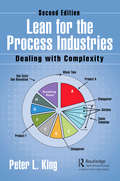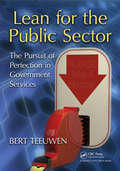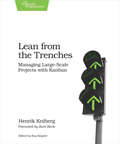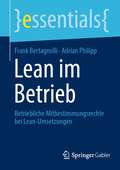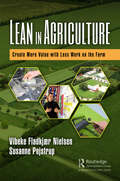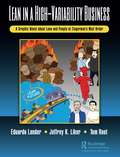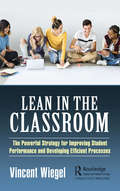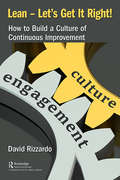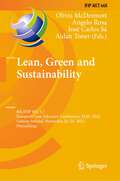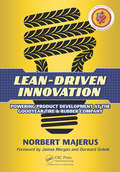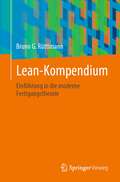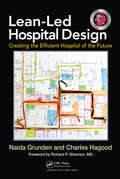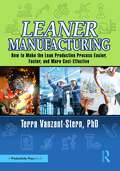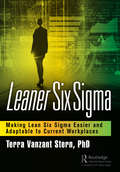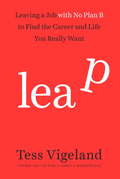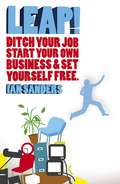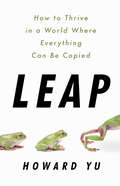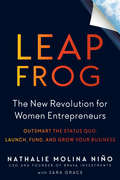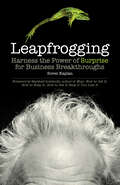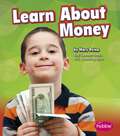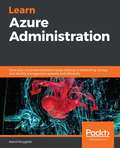- Table View
- List View
Lean for the Process Industries: Dealing with Complexity, Second Edition
by Peter L. KingCompared to its widespread implementation across almost all areas of production, Lean improvement efforts lag within the process industries. While many innovators have successfully applied Lean principles to these industries during the past three decades, most of those pioneering efforts were never recorded to guide the improvement efforts of others. Drawing on more than 40 years of application experience at one of the world’s largest chemical and materials manufacturers, coupled with 10 years in private practice, Peter King corrects this void by providing the first comprehensive resource written explicitly for change agents within the process industries. Focusing on areas where the improvement needs of the process industry differ from parts assembly manufacturing, Lean for the Process Industries: Dealing with Complexity, Second Edition: Covers each of the eight wastes commonly described in Lean literature, looking at how they manifest themselves in process operations. Explains how to adapt value stream mapping for process operations. Shows how to identify the root causes of bottlenecks, and how to manage them to optimize flow until they can be eliminated. Provides practical techniques to overcome the barriers which have prevented the application of Cellular Manufacturing to process operations. Discusses the role of business leadership in a Lean strategy, describing both enabling and counter-productive management behaviors Since the publication of the first edition of this book, Peter King has been busy consulting with food, beverage, gasoline additive, and nutraceutical companies -- these new experiences have broadened his perspectives on certain Lean processes and have given him a richer set of examples to discuss in this new edition. While Value Stream Mapping is a very powerful tool to understand flow, bottlenecks, and waste in an operation, the traditional format as presented in many other books does not describe all of the data required to fully understand process flow and its detractors. This new edition highlights the necessary additions with examples of why they are useful. Product wheel scheduling achieves production leveling in a far more comprehensive and effective way than traditional heijunka methods. This edition has a more thorough description of the wheel concept and design steps, and more examples from actual applications.
Lean for the Process Industries: Dealing with Complexity, Second Edition
by Peter L. KingCompared to its widespread implementation across almost all areas of production, Lean improvement efforts lag within the process industries. While many innovators have successfully applied Lean principles to these industries during the past three decades, most of those pioneering efforts were never recorded to guide the improvement efforts of others.Drawing on more than 40 years of application experience at one of the world’s largest chemical and materials manufacturers, coupled with 10 years in private practice, Peter King corrects this void by providing the first comprehensive resource written explicitly for change agents within the process industries. Focusing on areas where the improvement needs of the process industry differ from parts assembly manufacturing, Lean for the Process Industries: Dealing with Complexity, Second Edition: Covers each of the eight wastes commonly described in Lean literature, looking at how they manifest themselves in process operations. Explains how to adapt value stream mapping for process operations. Shows how to identify the root causes of bottlenecks, and how to manage them to optimize flow until they can be eliminated. Provides practical techniques to overcome the barriers which have prevented the application of Cellular Manufacturing to process operations. Discusses the role of business leadership in a Lean strategy, describing both enabling and counter-productive management behaviors Since the publication of the first edition of this book, Peter King has been busy consulting with food, beverage, gasoline additive, and nutraceutical companies -- these new experiences have broadened his perspectives on certain Lean processes and have given him a richer set of examples to discuss in this new edition.While Value Stream Mapping is a very powerful tool to understand flow, bottlenecks, and waste in an operation, the traditional format as presented in many other books does not describe all of the data required to fully understand process flow and its detractors. This new edition highlights the necessary additions with examples of why they are useful.Product wheel scheduling achieves production leveling in a far more comprehensive and effective way than traditional heijunka methods. This edition has a more thorough description of the wheel concept and design steps, and more examples from actual applications.
Lean for the Public Sector: The Pursuit of Perfection in Government Services
by Bert TeeuwenPacked with international case examples and clearly delineating principles as they apply to public sector organizations, Lean for the Public Sector: The Pursuit of Perfection in Government Services demonstrates that Lean in the public sector is neither rocket science nor a typical profit-driven improvement program. The book begins with coverage of
Lean from the Trenches: Managing Large-Scale Projects with Kanban
by Henrik KnibergYou know the Agile and Lean development buzzwords, you've read the books. But when systems need a serious overhaul, you need to see how it works in real life, with real situations and people. Lean from the Trenches is all about actual practice. Every key point is illustrated with a photo or diagram, and anecdotes bring you inside the project as you discover why and how one organization modernized its workplace in record time.Lean from the Trenches is all about actual practice.Find out how the Swedish police combined XP, Scrum, and Kanban in a 60-person project. From start to finish, you'll see how to deliver a successful product using Lean principles. We start with an organization in desperate need of a new way of doing things and finish with a group of sixty, all working in sync to develop a scalable, complex system. You'll walk through the project step by step, from customer engagement, to the daily "cocktail party," version control, bug tracking, and release. In this honest look at what works--and what doesn't--you'll find out how to:Make quality everyone's business, not just the testers.Keep everyone moving in the same direction without micromanagement.Use simple and powerful metrics to aid in planning and process improvement.Balance between low-level feature focus and high-level system focus.You'll be ready to jump into the trenches and streamline your own development process.
Lean im Betrieb: Betriebliche Mitbestimmungsrechte bei Lean-Umsetzungen (essentials)
by Frank Bertagnolli Adrian PhilippBei Lean-Umsetzungen benötigen Betriebe Rechtssicherheit. Dem Betriebsrat müssen Möglichkeiten und Grenzen bekannt sein. Da das Betriebsverfassungsgesetz den Rahmen setzt, Lean aber hierbei selten Einklang findet, unterstützt dieses Buch den praktischen Umgang bei Lean-Umsetzungen. Aufgezeigt werden typische Fallbeispiele und deren betriebsverfassungsrechtliche Einordnung. Dies soll allen Beteiligten Sicherheit geben. Lean ist für die Menschen einzusetzen, nicht gegen sie. Wenn Arbeitgeber und Arbeitnehmer Lean in einem ordnungsgemäßen Rahmen gemeinsam umsetzen, gewinnen alle, auch das Unternehmen selbst. Das Einsatzgebiet ist für diejenigen, welche in Lean-Projekten eingebunden sind. Besonders empfohlen sei es für Betriebsräte, Lean-Experten, Berater, Manager und Personaler.
Lean in Agriculture: Create More Value with Less Work on the Farm
by Susanne Pejstrup Vibeke Fladkjaer NielsenResponding to a recent surge in interest, this is the first book to comprehensively address how Lean thinking and tools can be implemented in agriculture. This handbook breaks down barriers, clearly showing how techniques originally developed for use in factories work just as well on farms. Expert Lean farming consultants Susanne Pejstrup and Vibeke Fladkjaer Nielsen present these methods in a clear, easy-to-read style, accessible to farmers the world over. Case studies from multiple farm types – including crops, pigs and dairy cattle – demonstrate how respect for people, continuous improvement and visual management techniques can improve resilience and profitability on the farm. Richly illustrated, Lean in Agriculture appeals not only to farmers, but to farm workers, food processing companies, veterinarians, consultants and other stakeholders in the agribusiness sector.
Lean in Agriculture: Create More Value with Less Work on the Farm
by Susanne Pejstrup Vibeke Fladkjaer NielsenResponding to a recent surge in interest and application, this book is the first to comprehensively address how Lean thinking and tools can be implemented in agriculture and agribusiness. This tactical guide breaks down barriers, clearly depicting how improvement techniques originally developed for factories can derive the same powerful results on farms.Expert Lean farming consultants, Susanne Pejstrup and Vibeke Fladkjaer Nielsen, present these methods in a clear, easy-to-read style, accessible to farmers all over the world. Case studies from multiple farm types – including crops, pigs and dairy cattle – demonstrate how respect for people, continuous improvement, and visual management techniques can improve resilience and profitability on the farm. Richly illustrated, Lean in Agriculture appeals not only to farmers, but to farm workers, food processing companies, veterinarians, consultants and other stakeholders in the agribusiness sector.Key Features: Translates Lean thinking into agricultural terms. Takes a people-centric approach to a Lean agricultural production system. Serves as an implementation guide , with clear writing and concise, easy-to-follow instructions tailored to the agricultural sector. Illustrates agriculture-specific Lean implementation with a wide range of case studies and memorable images.
Lean in a High-Variability Business: A Graphic Novel about Lean and People at Zingerman’s Mail Order
by Jeffrey K. Liker Eduardo Lander Thomas E. Root"John Dewey famously pointed out, 'We don't learn from experience. We learn from reflecting on experience.' Here's your chance to learn as the three authors reflect on the (successful) struggle to build a Lean production and management system at Zingerman's Mail Order. Thousands of people visit and benchmark ZMO. This book delivers the backstory in a richly illustrated way." -- Mike Rother, author of the bestselling books Toyota Kata and The Toyota Kata Practice Guide This clever and highly engaging graphic novel details a story about one organization’s Lean journey with inspiration from the Toyota Way. Over the years, common misunderstandings about what Lean is, what the journey is like, and how to advance have proliferated. Often, these misunderstandings come from the way people simplistically talk and think about Lean as if it is some concrete thing that you insert into an organization and step back to watch the results. The authors, however, view the organization as a living system with interacting parts and constant exposure to the environment. It is dynamic, so it’s hard to predict what obstacles you will face next. Just when you think you have it solved, new challenges arise from the market, competitors, government regulations, and every direction you turn to. When you look at your organization in this way, you see Lean through a different lens. The goal is to make your processes and people into a more adaptive system so you can navigate through all the complexity and uncertainty to continually achieve your goals. This is how Toyota views things and they summarize the Toyota Way as continuous improvement and respect for people. Each person becomes a partner in struggling to learn and adapt, and specific tools are used in very different ways throughout the company to accomplish their goals. The story presented here focuses on a small company called Zingerman’s Mail Order (ZMO). Tom Root was one of the founders of this spin-off of the Zingerman’s delicatessen. The deli was founded to bring high-quality artisanal food to Ann Arbor, Michigan. The purpose of this book is not to provide a "recipe for implementation" – the authors want you to get a feeling for the struggle, for the learning process. They explain and demonstrate many Lean tools within the context of the journey and how they were adapted for this particular business. Toyota kata became the centerpiece of developing scientific thinking skills to begin to bring continuous improvement to life.
Lean in the Classroom: The Powerful Strategy for Improving Student Performance and Developing Efficient Processes
by Vincent WiegelLean in the Classroom: The Powerful Strategy for Improving Student Performance and Developing Efficient Processes – Wiegel -- ISBN 9781138323131 - CAT# K392041 The current way of organizing education is not tenable in the coming decade. We need to address how we teach, how we organize schools, how we increase the effectiveness of learning, how we construct classrooms, and how we deploy new technologies. Lean management philosophy has been successfully applied across many industries – from manufacturing to healthcare, financial services, and construction. Recently, interest in Lean has steadily increased in the education sector, as it was originally introduced in that area’s administrative and support processes. Currently, the introduction of Lean and its potential in education is gaining wider exposure because of massive looming changes – for example, the introduction of technology in education (as EdTech within the traditional system and as MOOCs), demographic changes, budget pressure, new pedagogies, the entrance of more and more private providers, and changing demands of society and industry on the curriculum. What is missing is a joint framework that will allow schools, teachers, directors, and boards to harness the potential of these developments and then execute a strategy. Lean Education (LE) offers the potential to streamline the execution of strategy and teaching. It accelerates the development of new courses and studies that are closely aligned to the needs of students. It supports the integration of new technologies without overburdening teachers and staff. Lean in the Classroom brings all these elements together into a coherent framework so schools can make necessary changes in one concerted effort. Teaching, professional support, managing the daily work, and changing the way schools function are brought together as a schoolwide strategy to organize learning in a way that serves our students by making the most of their talents. This book is the first to define LE in all its aspects: course design, actual teaching and learning processes, school management, and the organization of supporting processes. It is firmly based on the Lean management philosophy in conjunction with pedagogy. The book draws on both scientific research in the field of Lean management in general and Lean education in particular. In addition, it is predicated on many years of hands-on experience applying Lean both inside and outside the education sector.
Lean – Let’s Get It Right!: How to Build a Culture of Continuous Improvement
by David RizzardoLean – Let’s Get It Right!: How to Build a Culture of Continuous Improvement (978-0-367-42991-1, 340939) Shelving Guide: Business & Management / Lean Management This book addresses the root causes of why a majority of Lean transformations have not met expectations. More importantly, it provides the information needed to turn around the failure mechanisms and transform them into critical success factors. Lean – Let’s Get It Right! delves into the psychology of change and motivation and clarifies the roles and responsibility changes which are required for alignment with Lean principles. While the author includes a review of Lean principles, the majority of the book either provides more depth of understanding of the principles or highlights how misalignment can thwart Lean transformation efforts. What this provides is not only clarity, but it establishes a solid reference point or framework to guide the Lean strategy. The reader will begin to see how the principles are not simply a random set of characteristics or features of Lean, but are actually a set of fundamental beliefs on which all else is based. Though repeated throughout the book that an organization must develop the specifics of their own Lean roadmap, this book concludes with guidance on making it happen. This book, with its primary focus on people, leadership, and principles, and less so on the details of tools and techniques, can be thought of as providing the few critical missing puzzle pieces to enable an effective Lean transformation.
Lean, Green and Sustainability: 8th IFIP WG 5.7 European Lean Educator Conference, ELEC 2022, Galway, Ireland, November 22–24, 2022, Proceedings (IFIP Advances in Information and Communication Technology #668)
by Olivia McDermott Angelo Rosa José Carlos Sá Aidan TonerThis book constitutes the refereed proceedings of the 8th European Lean Educator Conference ELEC 2022, which took place in Galway, Ireland, in November 2022; the event was sponsored by IFIP WG 5.7. The 28 full papers presented were carefully reviewed and selected for inclusion in the proceedings. They are organized in the following thematic sections: Lean & People; Lean in Healthcare; Lean 4.0; Lean in Manufacturing; Lean Learning in the Digital Era; Lean, Green & Sustainability; and Lean in Services.
Lean-Driven Innovation: Powering Product Development at The Goodyear Tire & Rubber Company
by Norbert MajerusIn 2005, Goodyear‘s research and development (RandD) engine was not performing up to its full potential. The RandD organization developed high-quality tires, but the projects were not always successful. Goodyear embarked on a major initiative to transform its innovation creation processes by learning, understanding, and applying lean product develo
Lean-Kompendium: Einführung in die moderne Fertigungstheorie
by Bruno G. RüttimannDas Buch befasst sich mit der grundlegenden Fertigungstheorie und entwickelt einen kartesischen Ansatz zur Erklärung von Lean. Es bietet eine strukturierte Grundlage, wie ein schlankes Fertigungssystem funktioniert. Studierende erhalten einen konsistenten Ansatz, der Lean mit zunehmender Komplexität (Monoprodukt, Multiprodukt, komplexe Fertigungssysteme) mit Theoremen, Korollarien und Lemmata erklärt. Ausbilder erhalten Erklärungen zu Lean auf der Grundlage eines systemischen Modells, das hilft, eine klare Sicht auf die Theorie von Lean zu vermitteln.
Lean-Led Hospital Design: Creating the Efficient Hospital of the Future
by Naida Grunden Charles HagoodInstead of building new hospitals that import old systems and problems, the time has come to reexamine many of our ideas about what a hospital should be. Can a building foster continuous improvement? How can we design it to be flexible and useful well into the future? How can we do more with less?Winner of a 2013 Shingo Prize for Operational Excell
Lean-Led Hospital Design: Creating the Efficient Hospital of the Future
by Naida Grunden Charles HagoodLean-Led Hospital Design explains how hospitals can be built to increase patient safety and reduce wait times while eliminating waste, lowering costs, and easing some of healthcare‘s most persistent problems. It supplies a simplified timeline of architectural planning from start to finish to guide readers through the various stages of the Lean design development philosophy, including Lean architectural design and Lean work design. It includes examples from several real healthcare facility design and construction projects, as well as interviews with hospital leaders and architects.
Leaner Manufacturing: How to Make the Lean Production Process Easier, Faster, and More Cost-Effective.
by Terra Vanzant-Stern, PhDLean Manufacturing, the production method first popularized by Toyota, has often been reduced to charts and tools by many US manufactures -- they've abandoned the original intent of the methodology. Many of the concepts and theories have becomes misconstrued, but systems such as Kanban (a Japanese concept used in Just-in-Time manufacturing) and applying core Lean principals to manufacturing remain valid today.This book promotes Leaner Manufacturing as next generation thinking involving the manufacturing process. It considers transformative tools that still work well, such as value stream mapping, and considers the manufacturing process as well as design theory.Leaner Manufacturing simplifies current manufacturing terms including the four categories of manufacturing: casting/ molding, machining, joining, and shearing/ forming in layman’s terms. This simplification creates an opportunity for invention and the process for applying and securing a patent would also be included.In addition, Leaner Manufacturing covers how to improve/modernize Kaizen Events (Rapid Improvement Events), Value Stream Mapping Processes, and Kanban practices as well as shows the power of using Agile Scrum practices and easier Lean Analytics.Essentially, Leaner Manufacturing simplifies the valid concepts of Lean Manufacturing as well as manufacturing, in general, to make various processes easier and less expensive to implement. It shows how to make Kaizen Events (Rapid Improvement Events) more effective. And, it provides a way for leaders to ensure buy-in from their teams and stakeholders and provide for a motivated and inspired workforce.
Leaner Six Sigma: Making Lean Six Sigma Easier and Adaptable to Current Workplaces
by Terra Vanzant Stern, PhDSince the 1980s, Lean and Six Sigma have been used independently to make existing processes better, faster and more cost effective. For almost twenty years, countless companies have embraced the power of blending the two process improvement methodologies. This has resulted in major financial successes throughout the world, but no one denies that we have learned a lot in the last two decades. Just in time to meet the challenges we will experience in 2020, and beyond, SSD Global Solutions has introduced Leaner Six Sigma (LrSS). LrSS makes the concepts and tools within these two popular methodologies easier and quicker to understand. Regardless, if you plan to take an industry-standard exam or simply want to apply critical-thinking and problem-solving models to your daily life, this book helps you rapidly navigate your path. Originally, to steer our way through traditional Six Sigma, it was necessary to understand complicated statistics. Then, with Lean, the heavy emphasis on manufacturing made it difficult to apply theories to the service sector. After the combination of Lean and Six Sigma became widespread, many of the core concepts still involved understanding historical references. Fast-forward, we now have spreadsheet-based calculators and programs that build charts and graphs in a couple of clicks. Many "Best Practices" have been established which allows for process improvements without re-inventing the wheel. Over the years, talented subject matter experts and practitioners have discovered useful shortcuts to make Lean Six Sigma, Leaner. This groundbreaking work shows how LrSS reduces the learning curve for those unfamiliar with quality initiatives. It streamlines the fundamentals for students wanting to take exams in Lean, Six Sigma or Lean Six Sigma. LrSS also provides the mature Lean Six Sigma practitioner, innovative techniques to explain Lean Six Sigma theories to the new user. Lean Six Sigma has served us well, but it is time to utilize all the lessons learned and software tools available today. It is time to embrace next-generation thinking with Leaner Six Sigma! Terra Vanzant Stern, PhD is also the author of Lean and Agile Project Management: How to Make Any Project Better, Faster, and More Cost Effective.
Leap
by Tess VigelandUntil recently, Tess Vigeland was a longtime host with Public Radio's Marketplace; it was a rewarding, high-status job, and Tess was very good at it--but she'd begun to feel restless. Without any definite, clear sense of what she wanted to do next (but an absolute certainty that what she'd been doing was no longer truly satisfying), she walked away from her dream job and into a vast unknown. Suddenly she was no longer "Marketplace's Tess Vigeland," she was just Tess Vigeland. For the multitude of Americans who change jobs mid-career (by choice or circumstance), the growing legions of freelance workers, and the entrepreneurially-minded who see self-employment as an increasingly more appealing and viable option, Tess Vigeland has created a personal and well-researched account of leaping without a net. With her signature humor, she writes honestly about the fear, uncertainty, and risk involved in leaving the traditional workforce--but also the excitement, resources, and possibilities that are on the other side. Part memoir and part field guide, this book offers a funny, thoughtful, and provocative look at how to find happiness, satisfaction, and success when pursuing a career less ordinary.
Leap!: Ditch Your Job, Start Your Own Business and Set Yourself Free
by Ian SandersWho Do You Think You Are? Times are changing fast. Traditional working practices and the concept of a conventional job are increasingly becoming things of the past as we make sense of a new marketplace where the only limit to success is our own imagination. What Does it take to Survive in This New Scrambled Up World of Work? * Attitude - to get started * Enterprise - to succeed * Success - at maximising opportunities * Worklife - in the right balance The challenges - and the opportunities - for the 'entrepreneur-within' the huge. For micro-businesses, home-workers, freelancers, it's all for the taking. That is the essence of LEAP! A stimulus for taking the plunge to go it alone and set yourself free... and for making it up as you go along! "Ian Sanders connects brilliantly wit the mindset and needs of talented professionals in their migration away from corporate mediocrity. LEAP! is a personal guidebook to both the practicality and emotion of making work matter." - Chris Nel, Partner, Tom Peters Company
Leap: How to Thrive in a World Where Everything Can Be Copied
by Howard YuEvery business faces the existential threat of competitors producing cheaper copies. Even patent filings, market dominance and financial resources can't shield them from copycats. So what can we do -- and, what can we learn from companies that have endured and even prospered for centuries despite copycat competition? In today&’s competitive environment where latecomers can replicate almost any product or service for less, and where intuition and market intelligence have been overtaken by machine algorithms, companies can no longer just be very good at what they do. The need to leap to new knowledge disciplines. The best leap repeatedly. And it&’s the combination of two skills – mastery of the old and new – that empowers them with the best competitive advantage. To discover how some companies not only survive but thrive for centuries, strategy expert Howard Yu identifies key trends from business history, skillfully extracting timeless lessons and applying them to today. He illustrates how managers can look to leverage technological shifts, increasingly ubiquitous connectivity, smart machines, and managerial creativity – in order to leap forward. Ultimately, Leap is a playbook for the future that shows how pioneering players can thrive by rethinking their business, their relationships with customers, and the very reasons they exist.
LeapFrog Enterprises
by Elizabeth Collins Lynda M. ApplegateExplores the success factors leading to the company's rise to the number three ranking in the aggressively competitive toy industry. LeapFrog has made the strategic decision to expand beyond the toy industry and enter the educational technology and services industry. While leveraging core capabilities and product platforms, this new industry requires that executives define a new business model. Senior executives face a number of challenges in implementing the new business and in sustaining the company's growth.
Leapfrog: The New Revolution for Women Entrepreneurs
by Nathalie Molina Niño Sara GraceFor women entrepreneurs (and anyone sick of the status quo), this smart, unapologetic collection delivers fifty proven hacks to leapfrog over obstacles and succeed in business."A must-read for any woman who has a great idea and the nagging thought that doors are closed to her; Molina Niño helps to blow them open."--Publishers WeeklyThink the most critical factor for becoming a great entrepreneur is grit, risk-taking, or technical skills? Think again. Despite what every other business book might say, historical data show the real secret ingredients to getting ahead in business are being rich, white, and male. Until now. Leapfrog is the decades-overdue startup bible for the rest of us. It's filled with uncompromising guidance for winning at business, your way. Leapfrog is for entrepreneurs of all stripes who are fed up with status quo advice--the kind that assumes you have rich friends and family and a public relations team.Refreshingly frank and witty, author Nathalie Molina Niño is a serial tech entrepreneur, the founder and CEO of BRAVA Investments, and a proud daughter of Latinx immigrants. While teaching budding entrepreneurs at Barnard College at Columbia University and searching the globe for investment-worthy startups, she has met or advised thousands of entrepreneurs who've gone from zero to scalable business. Here she shares their best secrets in the form of fifty "leapfrogs"--clever loopholes and shortcuts to outsmart, jump over, or straight up annihilate the seemingly intractable hurdles facing entrepreneurs who don't have family money, cultural capital, or connections.
Leapfrogging: Harness the Power of Surprise for Business Breakthroughs
by Soren KaplanHow did Gatorade revitalize itself in the wake of Red Bull and Starbucks? How did OpenTable come to be? What makes one company thrive while others languish in mediocrity? There’s no doubt hard work is involved, but Soren Kaplan shows you can’t do it by simply creating a big vision and implementing a set plan. In his trailblazing debut, Kaplan gives business leaders the tools to do exactly what they’re taught to avoid: embrace surprise—the new key to business breakthroughs. Instead of fighting against uncertainty, Kaplan reveals how to use it to break down limiting mindsets and barriers to change the game. By highlighting specific ways to transform both good and bad surprises into unique opportunities, Kaplan encourages leaders to compete by embracing counterintuitive ideas, managing paradoxes, and even welcoming failure. This is the key to “leapfrogging”—creating or doing something radically new or different that produces a significant leap forward. Leapfrogging connects new research, unconventional strategies, and practical tools for navigating the “messy” and elusive process of achieving business breakthroughs. Filled with real-world examples from innovators such as Gatorade, Intuit, Philips, Kimberly-Clark, Colgate-Palmolive, OpenTable, and Etsy, Kaplan shows that any organization or business function can leapfrog. Using his LEAPS process (Listen, Explore, Act, Persist, and Seize), leaders learn to seek out, recognize, and respond to surprising experiences and events as a way to create solutions that leap beyond the current expectations of customers, partners, employees, the market, and the competition. Kaplan’s Leapfrogging is the new handbook for the modern leader.
Learn About Money (Money and You)
by Mary ReinaCoins. Dollars. Euros. Yen. People use money to buy the things they want and need. But just what is money and why do we use it? Simple, yet engaging text and colorful images introduce young readers to money, how we use it, and different types of currency around the world.
Learn Azure Administration: Solve your cloud administration issues relating to networking, storage, and identity management speedily and efficiently
by Kamil MrzyglodEnhance your Azure administration and Azure DevOps skills and get up and running with networking, security, automation, and effective cost managementKey FeaturesExplore a variety of administration patterns used for different cloud architecturesDiscover best practices for administering various IT systems hosted in AzureAdminister, automate, and manage your Azure cloud environment effectivelyBook DescriptionMicrosoft Azure is one of the upcoming cloud platforms that provide cost-effective solutions and services to help businesses overcome complex infrastructure-related challenges. This book will help you scale your cloud administration skills with Microsoft Azure.Learn Azure Administration starts with an introduction to the management of Azure subscriptions, and then takes you through Azure resource management. Next, you'll configure and manage virtual networks and find out how to integrate them with a set of Azure services. You'll then handle the identity and security for users with the help of Azure Active Directory, and manage access from a single place using policies and defined roles. As you advance, you'll get to grips with receipts to manage a virtual machine. The next set of chapters will teach you how to solve advanced problems such as DDoS protection, load balancing, and networking for containers. You'll also learn how to set up file servers, along with managing and storing backups. Later, you'll review monitoring solutions and backup plans for a host of services. The last set of chapters will help you to integrate different services with Azure Event Grid, Azure Automation, and Azure Logic Apps, and teach you how to manage Azure DevOps.By the end of this Azure book, you'll be proficient enough to easily administer your Azure-based cloud environment.What you will learnExplore different Azure services and understand the correlation between themSecure and integrate different Azure componentsWork with a variety of identity and access management (IAM) modelsFind out how to set up monitoring and logging solutionsBuild a complete skill set of Azure administration activities with Azure DevOpsDiscover efficient scaling patterns for small and large workloadsWho this book is forThis book is for cloud administrators, system administrators, and IT professionals who want to scale up their skillset and enter the world of cloud computing. IT professionals and engineers who are already familiar with the basics of the Azure services and are looking for a step-by-step guide to solving the most common Azure problems will also find this book useful. Basic understanding of cloud concepts such as IaaS, PaaS, virtualization, networking, and common Azure services is required.
